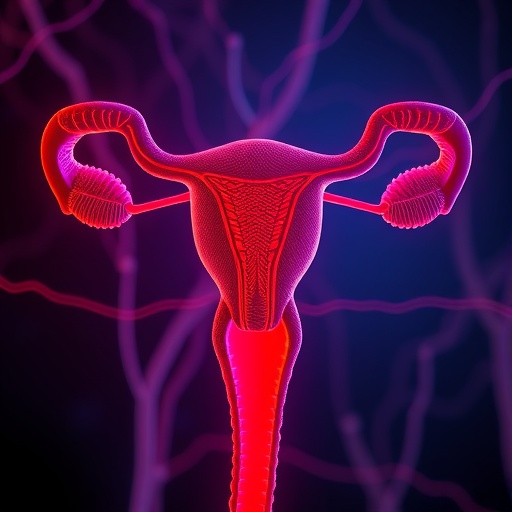In a groundbreaking discovery that is set to reshape our understanding of polycystic ovary syndrome (PCOS), a group of researchers led by Xu and colleagues has uncovered the intricate mechanisms by which hyperandrogenism drives ovarian inflammation and pyroptosis. This revelation not only enhances our understanding of the pathophysiology associated with PCOS but also identifies potential therapeutic targets to ameliorate reproductive dysfunction in affected individuals. In their study published in the coveted Journal of Ovarian Research, the authors detail the compelling link between elevated androgen levels and the activation of the Yes-associated protein (YAP), a key regulator in various cellular processes.
Hyperandrogenism is a well-known feature of PCOS, a common endocrine disorder affecting approximately one in ten women of reproductive age. It is characterized by irregular menstrual cycles, polycystic ovaries, and signs of hyperandrogenism, such as hirsutism and acne. The study emphasizes that while hyperandrogenism is often treated symptomatically, its systemic effects on ovarian function remain poorly understood. The researchers sought to investigate how excessive androgen levels could trigger YAP activation and subsequent inflammatory processes within the ovarian environment.
At the core of this research is the role of YAP, a protein that operates as a transcriptional co-activator and is integral to the regulation of cell proliferation, survival, and tissue homeostasis. YAP functions within the Hippo signaling pathway, which is renowned for its role in regulating organ size and preventing overgrowth. The activation of YAP has been linked to various pathological conditions, including cancer, but this study uniquely positions YAP in the context of ovarian inflammation and pyroptosis in PCOS patients.
Through in vitro and in vivo experiments, the researchers demonstrated that elevated androgen levels result in significant activation of YAP in ovarian cells. This finding is particularly compelling as it introduces a direct link between androgen excess and the dysregulation of ovarian physiology. The study found that YAP activation not only promotes cell survival but also incites a pro-inflammatory response characterized by the release of cytokines and chemokines that further exacerbate ovarian inflammation—a hallmark of PCOS.
Moreover, the study highlights the phenomenon of pyroptosis, a form of programmed cell death that is inflammatory in nature, as a consequence of YAP activation. Pyroptosis is distinct from other forms of cell death, primarily due to its inflammatory outcomes, which can propagate further tissue damage and dysfunction. The research indicates that hyperandrogenism leads to pyroptotic cell death within ovarian follicles, contributing to the follicular dysfunction commonly observed in PCOS patients.
Further exploration of the signaling pathways involved revealed that the effects of YAP in the ovarian environment could be mitigated through pharmacological interventions that target the Hippo pathway. Experimental treatments designed to inhibit YAP activity resulted in decreased inflammatory markers and restored normal ovarian function in models of hyperandrogenism. This finding carries significant implications for developing novel therapeutic strategies aimed at treating the underlying causes of PCOS rather than merely addressing its symptoms.
The implications of these findings extend beyond the realm of reproductive health. Given the systemic nature of PCOS, the identified link between hyperandrogenism, YAP activation, and inflammation may provide insights into broader metabolic disturbances associated with the condition. Women with PCOS often experience insulin resistance and an increased risk of developing type 2 diabetes, and the inflammatory processes activated by hyperandrogenism could contribute to these metabolic irregularities as well.
In discussing the future trajectory of this research, the authors stress the importance of clinical translation. Understanding the specific mechanisms by which YAP modulation can restore ovarian health offers a promising avenue for therapeutic intervention. Future studies are poised to investigate the efficacy of YAP inhibitors in clinical settings, providing hope for those affected by PCOS who struggle with limited treatment options.
The study’s findings reveal that the interconnectedness of hyperandrogenism and ovarian inflammation is more than just a coincidence; it’s a critical pathway that may define the reproductive health of women with PCOS. The establishment of YAP as a central player invites a reevaluation of how hormonal imbalances within the body contribute to chronic inflammatory states, potentially leading to innovative treatment paradigms that focus on precision medicine.
In conclusion, the groundbreaking findings from Xu and colleagues provide a fresh perspective on the role of hyperandrogenism in PCOS. The revelation that YAP activation can drive ovarian inflammation and pyroptosis opens new doors for research and potential therapies aimed at addressing not only the symptoms of PCOS but also its root causes. As researchers continue to unravel the complexities of this disorder, the hope is to move towards more effective interventions that can ultimately improve the quality of life for women battling PCOS.
The research sheds light on the urgent need for an integrated approach to understand and address PCOS holistically, taking into account the hormonal, metabolic, and inflammatory dimensions of the disease. As studies like this continue to emerge, the scientific community remains committed to translating these findings into actionable strategies that can profoundly impact the lives of millions of women across the globe.
With further evidence, scientists aspire to foster a deeper comprehension of how systematic interventions can not only treat but also prevent the myriad sequelae associated with this complex syndrome. The insights gleaned from this research herald a new era in PCOS management—a shift towards multifaceted interventions that may, at long last, dispel the shadow of this pervasive condition.
Subject of Research: Hyperandrogenism in Polycystic Ovary Syndrome
Article Title: Hyperandrogenism-mediated YAP activation drives ovarian inflammation and pyroptosis in PCOS: implications for follicular dysfunction.
Article References: Xu, T., Xiang, Y., Huang, Z. et al. Hyperandrogenism-mediated YAP activation drives ovarian inflammation and pyroptosis in PCOS: implications for follicular dysfunction. J Ovarian Res 18, 170 (2025). https://doi.org/10.1186/s13048-025-01757-5
Image Credits: AI Generated
DOI: 10.1186/s13048-025-01757-5
Keywords: Polycystic Ovary Syndrome, Hyperandrogenism, YAP Activation, Inflammation, Pyroptosis, Follicular Dysfunction.




